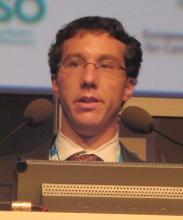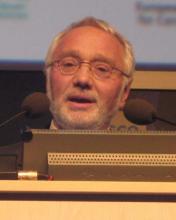STOCKHOLM – The results of the largest clinical trial to date in malignant pleural mesothelioma have left patients still without a standard second-line-treatment for this deadly tumor in the chest lining.
"Vorinostat [Zolinza] did not improve survival compared with placebo," Dr. Lee M. Krug said at the European Multidisciplinary Cancer Congress, where he reported outcomes of the disappointing phase III VANTAGE 014 trial.
Overall survival was not significantly different with a median of 31 weeks in patients on vorinostat and 27 weeks in those on placebo (hazard ratio, 0.98; P = 0.858). Planned analyses found no subgroups had any advantage in overall survival from vorinostat, said Dr. Krug of Memorial Sloan-Kettering Cancer Center in New York City.
Discussant Dr. Rolf A. Stahel of the University Hospital Zurich lamented, "This has been the largest study ever in mesothelioma. ... Despite this huge effort, the result is negative."
Patients were included if they had a diagnosis of malignant pleural mesothelioma with a pleural lesion at least 1 cm in thickness. They could have received up to two prior systemic regimens with pemetrexed (Alimta) and a platinum. They had to have a Karnofsky performance status of at least 70 and adequate organ function.
Vorinostat is a histone deacetylase (HDAC) inhibitor. In all, 660 patients were randomized to vorinostat (300 mg) or placebo. Both were given orally twice daily for 3 days out of 7 days in a 3-week cycle. The population was predominantly male, with a slightly greater percentage in the vorinostat arm (86% vs. 81%). Almost all patients (90%) had stage III-IV disease.
Researchers were puzzled by a change in survival rates in patients who were measured at the time of the third interim analysis, compared with those who were enrolled after the third interim analysis, said Dr. Krug.
At the third interim analysis, the hazard ratio for overall survival was 0.86, "which was just shy of the 0.83 hazard ratio required for this to be a positive trial." After the interim analysis – which occurred halfway through the study – the hazard ratio was 1.32.
The test of interaction between survival effect and time of enrollment, suggested that there was a less-than-2% chance that this switch occurred randomly. "As yet, we have not identified any causes," Dr. Krug said.
Median progression-free survival (determined by independent radiologic review) was significantly improved statistically in the vorinostat arm but not in a clinically-significant way: 6.3 weeks for vorinostat vs. 6.1 weeks for placebo (HR, 0.75; P less than 0.001).
Secondary end points (overall objective response rate, the dyspnea score on the Lung Cancer Symptom Scale as modified for mesothelioma, and forced vital capacity – were no better with vorinostat than with placebo. There were two confirmed radiologic responses, one in each arm.
"The adverse events were comparable between the two arms. ... [S]erious adverse events were slightly increased for some toxicities that you might expect to see with vorinostat," said Dr. Krug. These included fatigue, nausea, and dehydration. Tumor pain was greater in the placebo arm.
Despite the negative results, just by its sheer size, the trial "provides an excellent source of information with regards to this patient population, such as data on their pulmonary function, [symptomatology], serum markers, and also the large tumor bank that was collected," Dr. Krug told attendees at the joint congress of the European Cancer Organization (ECCO), the European Society For Medical Oncology (ESMO) and the European Society for Radiotherapy and Oncology (ESTRO).
The study was supported by Merck Laboratories. No conflicts were reported at the meeting. Dr. Krug previously reported relationships with numerous companies, including receiving research funding from Merck.



